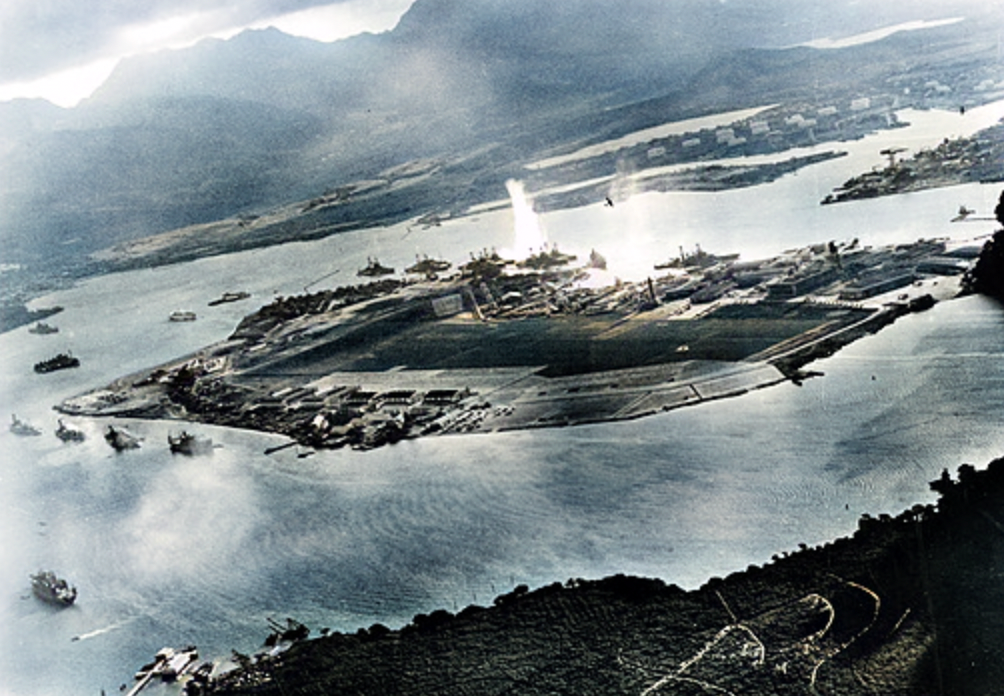1941 WAS a year of escalating political tensions, dramatic cultural shifts, and significant global developments. Nazi Germany intensified its war efforts with the invasion of the Soviet Union (Operation Barbarossa) and continued its dominance in Europe. Meanwhile, Japan's aggressive expansion in the Pacific led to the attack on Pearl Harbor, drawing the United States into World War II. In the UK, the war effort continued with both military engagements and civilian resilience. On the cultural front, Hollywood continued to define global cinema, while political shifts shaped the fate of nations across the globe.
You can even discover 1941 events for yourself in a 1941 newspaper ... Browse our archives and purchase your own today!
Turn the page to:
January
February
March
April
May
June
July
August
September
October
November
December
Key Events of 1941
January
January 3: The United Kingdom strengthens its air defence systems in response to growing concerns of Nazi air raids.
January 7: The US Congress passes the Lend-Lease Act, allowing the US to supply military aid to Allied nations, signifying a shift in its policy of neutrality.
January 12: In the Pacific, Japanese forces begin their major territorial expansions in Southeast Asia, including the invasion of French Indochina.
January 19: The Soviet Union establishes new alliances with the Allied powers as tensions with Nazi Germany escalate.
January 28: The US government begins to mobilise its military for potential involvement in the European conflict.
Shop our book on WWII to learn more through newspaper headlines ...

February
February 1: Japan signs a military pact with Germany and Italy, strengthening its involvement in the Axis Powers.
February 4: In the United States, President Franklin D. Roosevelt delivers a key speech supporting the Lend-Lease Act, emphasising the importance of supporting Allies against Nazi aggression.

President Franklin D. Roosevelt signing the Lend-Lease Act. Image: Wikimedia
February 10: The Battle of the Atlantic intensifies as German U-boats target Allied shipping lanes, crippling the British supply chain.
February 14: The Soviet Union strengthens its alliances with the United States by agreeing to exchange military intelligence.
February 20: The Royal Navy engages in multiple naval skirmishes with the German Kriegsmarine in the Mediterranean Sea.
February 27: The US and UK hold their first high-level meetings to discuss coordinated military strategy against Axis powers.
February 28: The US Navy begins a covert campaign of military support in the Pacific region, focusing on supply lines to the Philippines.
March
March 3: In the United States, the Army Air Corps begins an experimental aerial bombing campaign, testing new tactics to support allied forces in Europe.
March 9: The US increases its foreign military aid to the UK and France, as tensions escalate across the globe.
March 17: The Royal Navy successfully blocks the German Navy from gaining access to key trade routes across the Atlantic.
March 19: The Soviet Union consolidates its military control over key eastern territories as Nazi Germany struggles to penetrate Soviet defences.
March 24: The US Army begins preparations for potential future mobilization in the event of full entry into the war.
March 29: In Asia, Japan begins to strengthen its naval presence in the South China Sea.
April
April 1: The Great Depression continues to affect economies globally, with unemployment rates remaining high across Europe and the United States.
April 10: The United States announces plans to develop long-range military aircraft, indicating a significant step toward modernising the country’s defence capabilities.
April 14: The UK holds a major industrial exhibition, showcasing technological advancements and Britain’s increasing industrial power.
April 17: In Japan, military leaders intensify their push for territorial expansion in China, planning a full-scale invasion of southern China.
April 20: The UK begins to increase military preparations in response to the growing likelihood of war, conducting extensive air raid drills.
April 23: A massive strike by coal miners paralyses the UK’s mining industry, as workers demand better wages and improved conditions.
May
May 1: The US military strengthens its naval presence in the Atlantic Ocean, in response to growing fears of Nazi submarine activity.
May 3: The United Kingdom launches a major aerial campaign over Germany, targeting key military installations.
May 6: In Asia, Japan expands its control over Burma, signaling a new phase of territorial conquest in Southeast Asia.
May 8: The Soviet Union begins to fortify key eastern positions in anticipation of further German advances.
May 10: The United States enacts new sanctions against Japan, in response to its continued expansion in the Pacific.
May 18: The Royal Air Force continues strategic air strikes over Germany, damaging vital military infrastructure.
June
June 1: The US increases its military aid to the Soviet Union, in a bid to strengthen the Eastern Front against Germany.
June 15: The UK implements new rationing measures in response to the ongoing air raids.
June 20: Soviet forces launch a surprise counterattack in Leningrad, aiming to regain lost ground.
June 22: The German forces continue their invasion of the Soviet Union. This marks the beginning of Operation Barbarossa, the largest military operation in history.
June 25: US forces are stationed along the Pacific islands as the threat of Japanese expansion continues to grow.
June 30: The Royal Air Force launches a surprise air raid on Berlin, striking key military targets.
July
July 1: The US government authorises further military expansion, increasing funding for weapons production and defence systems.
July 4: In Europe, Allied forces continue to launch strategic air strikes on German military installations.
July 10: Japan increases its territorial control over China, particularly focusing on the Yangtze River Valley.
July 13: Soviet forces attempt a counter-offensive against Nazi Germany, marking a crucial turning point on the Eastern Front.
July 18: The UK continues strategic bombing raids over German-occupied territories, with particular focus on aircraft factories and military infrastructure.
July 21: US forces are placed on alert as Japanese forces begin targeting key military installations in the Pacific.
July 23: The Royal Navy engages in a series of naval battles with Italian forces in the Mediterranean Sea.
July 30: Nazi forces achieve a key victory over Soviet defences in the Battle of Smolensk.
August
August 4: Japan continues its military occupation of French Indochina, strengthening its control in the region.
August 13: The UK implements new rationing measures in response to the ongoing air raids.

Ration book. Image: Wikipedia
August 15: German forces move into Ukraine, seizing key territories and industrial assets.
August 20: Soviet forces launch a tactical retreat from the Eastern Front, consolidating in more defensible positions.
August 25: US forces are stationed along the Pacific islands as the threat of Japanese expansion continues to grow.
August 30: The Royal Air Force carries out heavy raids over Nazi Germany, focusing on aircraft factories and military infrastructure.
September
September 4: Japan strengthens its naval presence in South East Asia, aiming for greater control over vital sea lanes.
September 8: The UK announces the beginning of military conscription, expanding the size of its armed forces.
September 15: US forces are placed on alert as Japanese forces begin targeting key military installations in the Pacific.
September 20: The Soviet Union suffers significant losses, with over half a million troops falling to German advances.
September 25: The Royal Navy successfully defeats Italian forces in a naval battle near Malta.
September 29: The US increases its foreign military assistance to China in response to continued Japanese aggression.
October
October 1: Japan continues its expansion in South East Asia, with new territorial gains in the Philippines.
October 5: Germany begins extensive bombing campaigns targeting Allied cities throughout Europe.
October 10: The US Army engages in a secret military operation to help defend the Philippines.
October 15: Royal Air Force conducts major strategic raids on German military factories in occupied France.
October 20: Soviet forces begin a tactical retreat from the Eastern Front, consolidating in more defensible positions.
November
November 3: The United Kingdom initiates the first wave of training programs for air defence in preparation for Nazi air raids.
November 8: US forces strengthen their position in the Pacific, preparing for any possible conflicts with Japanese forces.
November 12: Soviet forces mount a counteroffensive in Eastern Europe, pushing back German military forces.
November 17: Royal Navy expands its naval operations in the Mediterranean to disrupt Axis supply lines.
December
December 1: Soviet forces continue to engage Nazi forces along the Eastern Front as German air raids intensify.
December 7: Japan launches the attack on Pearl Harbor, drawing the United States into World War II.
Shop our Pearl Harbor book to learn more through newspaper headlines ...

December 15: US forces begin military operations in the Pacific against Japanese naval units.
December 25: Germany launches a new wave of military offensives along the Eastern Front to continue their advances towards Moscow.

Attack on Pearl Harbor. Image: Wikimedia
Key Events of 1941
Operation Barbarossa:
ONE of the most significant events of 1941 was the German invasion of the Soviet Union, known as Operation Barbarossa. This was the largest military invasion in history and marked the beginning of a brutal conflict on the Eastern Front. Over 3 million German soldiers invaded Soviet territory, marking a decisive turning point in the conflict. Despite initial successes, the Germans faced fierce Soviet resistance, and the campaign would eventually lead to their defeat at Stalingrad by 1943.
Attack on Pearl Harbor:
ON DECEMBER 7, Japan launched a devastating surprise attack on Pearl Harbor, bringing the United States into World War II. This event led to the United States declaring war on Japan and subsequently entering both the Pacific and European waters. The attack killed over 2,400 people, destroyed nearly half of the US Pacific Fleet, and was a critical moment in shifting the balance of the war.
The Battle of Britain:
THROUGHOUT 1941, the Battle of Britain continued with heavy air raids by Germany on London and other cities. This conflict was a critical moment in the war as it marked the first major defeat of Hitler’s military forces. The Royal Air Force, supported by British civilians, successfully repelled the German Luftwaffe through strategic air defences and radar technology, preventing a German invasion of Britain.


























Follow us